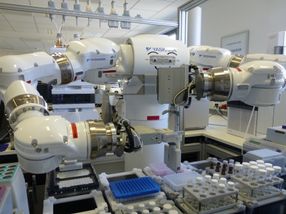Novel technology opens the door to the understanding of and possible treatments for obesity, diabetes, ageing and cancer
Seahorse Bioscience Announces the XF96 Extracellular Flux Analyzer for Cellular Bioenergetics
Seahorse Bioscience announced the release of the first ever analytical instrument for the kinetic measurement of mitochondrial oxygen consumption and cytoplasmic glycolysis in cells in a 96 well microplate. For the past 75 years tools for measuring cellular bioenergetics have been relatively unchanged since Warburg designed the Warburg Apparatus in 1932 and Leland Clarkinvented the Clark oxygen electrode in 1959.
"Without oxygen consumption measurements, the study of cellular bioenergetics would be in the dark ages," said David Nicholls, a bioenergetic researcher from Lund University and the Buck Institute. "Respiratory measurements allow us to quantify subtle changes in ATP turnover, mitochondrial uncoupling or respiratory chain inhibition that can immediately identify an interaction of a compound with the cell's energy generation pathways. Prior to the Seahorse, such studies were restricted to laborious single oxygen consumption measurements using the Clark electrode, invented in 1959, that required large amounts of material and was unsuitable for attached cells. The Seahorse requires just 2% of the material previously needed and has 100-fold the throughput! The ability to analyze cell (and therefore mitochondrial) respiration in a 96 well format and at the same time measure glycolytic flux will result in an immediate surge of scientific discoveries and new drugs. In particular it can lead to an early warning if a potential drug interacts with the cell's bioenergetic pathways."
Martin Brand, a mitochondrial researcher from the Buck Institute and the MRC Dunn Human Nutrition Unit comments, "I have been performing individual measurements of oxygen consumption and lactate production using cell suspensions for the greater part of my career and I trust Seahorse's XF technology, which allows us to make multiple simultaneous measurements of oxygen consumption and acid production using cells growing on culture plates," he said. "The XF format allows us to analyze the bioenergetics of cells under normal growth conditions with high throughput, greatly expanding our ability to investigate cellular bioenergetics."
"Seahorse provides a physiologically relevant assay for detecting the effect of RNAi knockdown of mitochondrial genes on cellular bioenergetics," added Vamsi Mootha, from the Broad Institute, MIT and Harvard's Massachusetts General Hospital. "This technology may accelerate the discovery of drugs for mitochondrial diseases."
The XF96 extracellular flux analyzer was developed to provide higher throughput analysis for customers desiring to study mitochondrial function and dysfunction, obesity, diabetes, cancer, ageing disorders, cardiac disease and drug toxicity.
"The first published Seahorse data was reported in a 2006 Nature article. We have been impressed with the breadth and number of new discoveries by the early users of our technology. In only two years, since the introduction of the first XF24 instrument, XF technology has become the new standard for measuring oxygen consumption and glycolysis by cells, replacing the 50 year old Clark Electrode," notes Jay Teich, CEO, Seahorse Bioscience. "And we are confident the XF96 will have a greater impact."
The new XF96 measures the two primary metabolic pathways in cells in minutes, using a label-free, non-destructive method. The easy to use instrument takes little lab space, does not disrupt stand cell culture procedures and provides measurement c.v.'s under 5%, approximately four times better than has been achievable using older technologies.
Most read news
Organizations
Other news from the department research and development

Get the analytics and lab tech industry in your inbox
By submitting this form you agree that LUMITOS AG will send you the newsletter(s) selected above by email. Your data will not be passed on to third parties. Your data will be stored and processed in accordance with our data protection regulations. LUMITOS may contact you by email for the purpose of advertising or market and opinion surveys. You can revoke your consent at any time without giving reasons to LUMITOS AG, Ernst-Augustin-Str. 2, 12489 Berlin, Germany or by e-mail at revoke@lumitos.com with effect for the future. In addition, each email contains a link to unsubscribe from the corresponding newsletter.


























































